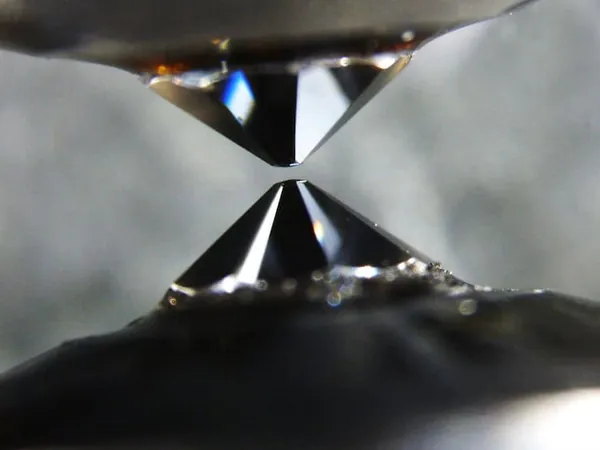
Breakthrough Discovery: Superconducting Phenomena Unveiled in Hydrogen Sulphides!
2025-05-12
Author: Wei Ling
A Revolutionary Development in Superconductivity
In a groundbreaking revelation from Germany, scientists have successfully measured a superconducting gap in hydride sulphide materials for the very first time. This vital discovery serves as 'smoking gun' evidence supporting superconductivity in these enigmatic compounds and confirms that the electron pairing at play is orchestrated by phonons.
What Are Superconductors?
Superconductors are materials that can conduct electricity without any resistance! While many traditionally require extremely low temperatures to function—as demonstrated by mercury, which has a critical temperature (Tc) of just 4.2 K—researchers are fervently pursuing superconductors that can operate at much higher temperatures. Achieving superconductivity at ambient temperatures would not only revolutionize electrical systems but also exponentially improve the efficiency of generators and power transmission lines.
The Rise of Superhydrides
The journey toward room temperature superconductors gained momentum during the 1980s and 1990s with the emergence of high-temperature superconductors, particularly copper oxides that boast Tcs ranging from 30 to 133 K. Fast forward to 2015, and the bar was raised to an astonishing 203 K with the discovery of H3S under pressures of 150 GPa.
This remarkable progress ignited extensive research into solid materials that incorporate hydrogen atoms. In 2019, lanthanum decahydride (LaH10) shattered records again, revealing a whopping Tc of 250–260 K, albeit at very high pressures. The excitement continued into 2021 with cerium hydrides like CeH9 and CeH10, which displayed superconductivity at significantly lower pressures around 80 GPa.
Unpacking the Mechanism of Superconductivity
Amidst this whirlwind of discoveries, one critical question loomed: how does superconductivity manifest in superhydrides? The Bardeen–Cooper–Schrieffer (BCS) theory suggests that superconductivity arises when electrons pair up, overcoming their natural repulsion. These pairs, or Cooper pairs, then flow through the material effortlessly, avoiding obstacles like phonons or impurities.
A defining feature of this pairing is the presence of a distinct energy gap near the Fermi level—the highest energy level that electrons can occupy at absolute zero. Identifying this gap is recognized as concrete proof of superconductivity, yet for superhydrides, measuring this gap poses a significant challenge due to the extreme pressures required for these materials.
A New Technique: Planar Electron Tunnelling Spectroscopy
Enter a team from Germany's Max Planck Institute for Chemistry that has now developed a pioneering method capable of operating under these severe conditions. The innovative technique, known as planar electron tunnelling spectroscopy, involved creating highly pure planar junctions of H3S and its deuterated counterpart D3S under pressures exceeding 100 GPa.
Through a process called laser heating, the researchers crafted junctions made up of tantalum metal, a tantalum pentoxide barrier, and the superconductors. By meticulously measuring the differential conductance across these junctions, they were able to uncover vital information about the electron states in H3S and D3S.
Their findings revealed fully open superconducting gaps of 60 meV for H3S and 44 meV for D3S. Notably, the smaller gap in D3S reinforces the notion that the superconductivity in H3S arises from electron-phonon interactions, corroborating longstanding theoretical predictions!
The Future of Superconductivity is Bright!
This groundbreaking research opens new avenues in the exploration of high-temperature superconductors, inching us closer to the dream of room temperature superconductivity. Stay tuned as scientists continue to unravel the mysteries of these extraordinary materials!



 Brasil (PT)
Brasil (PT)
 Canada (EN)
Canada (EN)
 Chile (ES)
Chile (ES)
 Česko (CS)
Česko (CS)
 대한민국 (KO)
대한민국 (KO)
 España (ES)
España (ES)
 France (FR)
France (FR)
 Hong Kong (EN)
Hong Kong (EN)
 Italia (IT)
Italia (IT)
 日本 (JA)
日本 (JA)
 Magyarország (HU)
Magyarország (HU)
 Norge (NO)
Norge (NO)
 Polska (PL)
Polska (PL)
 Schweiz (DE)
Schweiz (DE)
 Singapore (EN)
Singapore (EN)
 Sverige (SV)
Sverige (SV)
 Suomi (FI)
Suomi (FI)
 Türkiye (TR)
Türkiye (TR)
 الإمارات العربية المتحدة (AR)
الإمارات العربية المتحدة (AR)